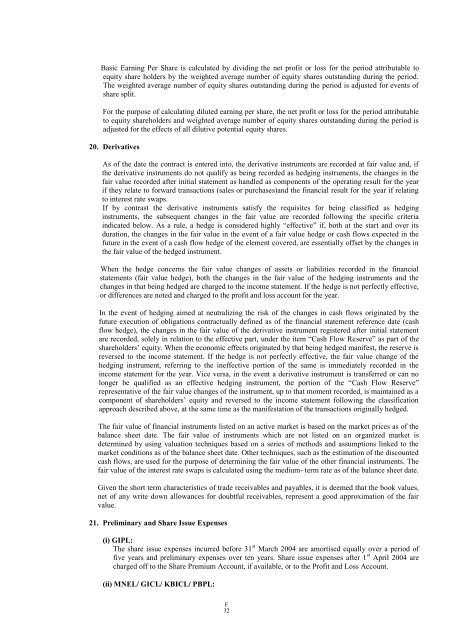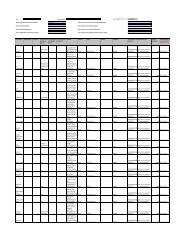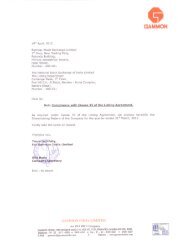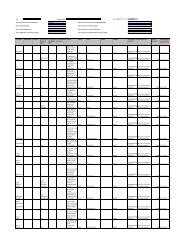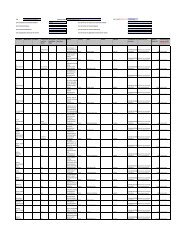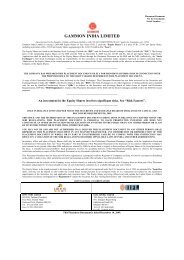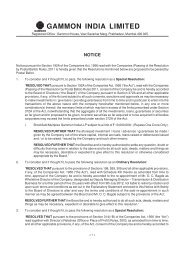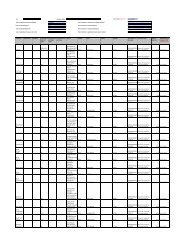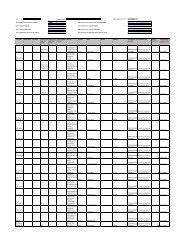GAMMON INDIA LIMITED
GAMMON INDIA LIMITED
GAMMON INDIA LIMITED
You also want an ePaper? Increase the reach of your titles
YUMPU automatically turns print PDFs into web optimized ePapers that Google loves.
Basic Earning Per Share is calculated by dividing the net profit or loss for the period attributable to<br />
equity share holders by the weighted average number of equity shares outstanding during the period.<br />
The weighted average number of equity shares outstanding during the period is adjusted for events of<br />
share split.<br />
For the purpose of calculating diluted earning per share, the net profit or loss for the period attributable<br />
to equity shareholders and weighted average number of equity shares outstanding during the period is<br />
adjusted for the effects of all dilutive potential equity shares.<br />
20. Derivatives<br />
As of the date the contract is entered into, the derivative instruments are recorded at fair value and, if<br />
the derivative instruments do not qualify as being recorded as hedging instruments, the changes in the<br />
fair value recorded after initial statement as handled as components of the operating result for the year<br />
if they relate to forward transactions (sales or purchases)and the financial result for the year if relating<br />
to interest rate swaps.<br />
If by contrast the derivative instruments satisfy the requisites for being classified as hedging<br />
instruments, the subsequent changes in the fair value are recorded following the specific criteria<br />
indicated below. As a rule, a hedge is considered highly “effective” if, both at the start and over its<br />
duration, the changes in the fair value in the event of a fair value hedge or cash flows expected in the<br />
future in the event of a cash flow hedge of the element covered, are essentially offset by the changes in<br />
the fair value of the hedged instrument.<br />
When the hedge concerns the fair value changes of assets or liabilities recorded in the financial<br />
statements (fair value hedge), both the changes in the fair value of the hedging instruments and the<br />
changes in that being hedged are charged to the income statement. If the hedge is not perfectly effective,<br />
or differences are noted and charged to the profit and loss account for the year.<br />
In the event of hedging aimed at neutralizing the risk of the changes in cash flows originated by the<br />
future execution of obligations contractually defined as of the financial statement reference date (cash<br />
flow hedge), the changes in the fair value of the derivative instrument registered after initial statement<br />
are recorded, solely in relation to the effective part, under the item “Cash Flow Reserve” as part of the<br />
shareholders‟ equity. When the economic effects originated by that being hedged manifest, the reserve is<br />
reversed to the income statement. If the hedge is not perfectly effective, the fair value change of the<br />
hedging instrument, referring to the ineffective portion of the same is immediately recorded in the<br />
income statement for the year. Vice versa, in the event a derivative instrument is transferred or can no<br />
longer be qualified as an effective hedging instrument, the portion of the “Cash Flow Reserve”<br />
representative of the fair value changes of the instrument, up to that moment recorded, is maintained as a<br />
component of shareholders‟ equity and reversed to the income statement following the classification<br />
approach described above, at the same time as the manifestation of the transactions originally hedged.<br />
The fair value of financial instruments listed on an active market is based on the market prices as of the<br />
balance sheet date. The fair value of instruments which are not listed on an organized market is<br />
determined by using valuation techniques based on a series of methods and assumptions linked to the<br />
market conditions as of the balance sheet date. Other techniques, such as the estimation of the discounted<br />
cash flows, are used for the purpose of determining the fair value of the other financial instruments. The<br />
fair value of the interest rate swaps is calculated using the medium- term rate as of the balance sheet date.<br />
Given the short term characteristics of trade receivables and payables, it is deemed that the book values,<br />
net of any write down allowances for doubtful receivables, represent a good approximation of the fair<br />
value.<br />
21. Preliminary and Share Issue Expenses<br />
(i) GIPL:<br />
The share issue expenses incurred before 31 st March 2004 are amortised equally over a period of<br />
five years and preliminary expenses over ten years. Share issue expenses after 1 st April 2004 are<br />
charged off to the Share Premium Account, if available, or to the Profit and Loss Account.<br />
(ii) MNEL/ GICL/ KBICL/ PBPL:<br />
F<br />
32


